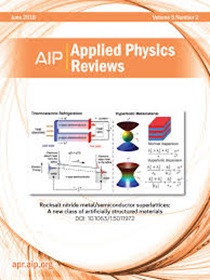在过氧化锡/硅串联太阳能电池中使用氧化锡作为缓冲层的工作机制
IF 11.9
1区 物理与天体物理
Q1 PHYSICS, APPLIED
引用次数: 0
摘要
氧化锡(SnOX)是一种缓冲层,通常用于在钙钛矿相关串联太阳能电池的顶部电池中沉积透明导电氧化物时保护电子传输层和钙钛矿层免受溅射引起的损伤,被认为是实现高效率的必要条件。本文系统地研究了SnOX对单结钙钛矿太阳能电池的影响,以了解SnOX在钙钛矿顶部电池中的工作机制。我们通过稳态光致发光、外量子效率、空间电荷限制电流测量和数值模拟来讨论SnOX过程与光伏参数之间的关系。我们观察到,随着SnOX厚度的增加,效率增加,结果表明,SnOX厚度不仅降低了钙钛矿太阳能电池的串联电阻,而且有可能抑制非辐射复合。改进的缓冲层最终用于生产效率为32.84%的钙钛矿/硅串联太阳能电池(利用外部量子效率测量的短路电流密度计算出相应的效率为31.81%)。本文章由计算机程序翻译,如有差异,请以英文原文为准。
Toward the working mechanisms of tin oxide as buffer layer in perovskite/silicon tandem solar cells
Tin oxide (SnOX), a buffer layer commonly used to protect both the electron transport layer and the perovskite layer from sputtering-induced damage during the deposition of transparent conductive oxide in the top cell of perovskite-related tandem solar cells, is considered essential for achieving high efficiencies. Here, we systematically investigate the impact of SnOX on single-junction perovskite solar cells to understand the working mechanism of SnOX in the perovskite top cells. We discuss the correlation between the SnOX process and the photovoltaic parameters using steady-state photoluminescence, external quantum efficiency, space-charge-limited current measurements, and numerical simulations. We observe that the efficiency increased with thicker SnOX and the results suggest that thicker SnOX not only decreases the series resistance of perovskite solar cells but also has the potential to suppress nonradiative recombination. The improved buffer layer is finally used to produce a perovskite/silicon tandem solar cell with an efficiency of 32.84% (with a corresponding efficiency of 31.81% calculated using the short-circuit current density from the external quantum efficiency measurements).
求助全文
通过发布文献求助,成功后即可免费获取论文全文。
去求助
来源期刊

Applied physics reviews
PHYSICS, APPLIED-
CiteScore
22.50
自引率
2.00%
发文量
113
审稿时长
2 months
期刊介绍:
Applied Physics Reviews (APR) is a journal featuring articles on critical topics in experimental or theoretical research in applied physics and applications of physics to other scientific and engineering branches. The publication includes two main types of articles:
Original Research: These articles report on high-quality, novel research studies that are of significant interest to the applied physics community.
Reviews: Review articles in APR can either be authoritative and comprehensive assessments of established areas of applied physics or short, timely reviews of recent advances in established fields or emerging areas of applied physics.
 求助内容:
求助内容: 应助结果提醒方式:
应助结果提醒方式:


